You're using an outdated browser. Please upgrade to a modern browser for the best experience.
Please note this is an old version of this entry, which may differ significantly from the current revision.
Subjects:
Energy & Fuels
The BESS is significant in providing ancillary services to the grid. The BESS plays a crucial role in facilitating the integration of RES into the grid by compensating for the fluctuations produced by RESs as intermittent resources. Ancillary services encompass all the services necessary for the grid operator (transmission and distribution operator) to maintain the system’s integrity, stability, and power quality. Grid operators ensure a reliable power supply, frequency, voltage, and power load within certain limits.
- ancillary services
- control techniques
- energy storage
- flow battery
- Lithium-Ion battery
1. Introduction
The integration of renewable energy sources (RESs) and the optimization of energy grids relies heavily on energy storage systems (ESSs) to function effectively since RESs are intermittent in nature and often create temporal negative effects between energy availability and user demands. Additionally, ESS is critical for the stability of power grids, the amalgamation of RESs, and optimizing the overall performance of energy systems. Batteries can be used as an ESS in smoothing the power output and managing the ramp rate of RES power plants to reduce unexpected voltage and power fluctuations on the electrical grid. Moreover, the above solutions are important for managing the deployment of RES, electrified transportation advancements, and smart grid development. With the deployment of RESs and enhanced electrified transportation, the marketplace for large-scale stationary energy storage (ES) has experienced rapid growth [1,2]. In addition, various technologies of electrochemical energy storage (EES) systems, for instance, electrochemical batteries, redox flow batteries, and other emerging storage technologies, are being developed and researched to meet the growing demand for ES solutions. EESs offer effective solutions thanks to their outstanding traits such as elevated energy concentration, flexibility, and scalability [2]. The EES also demonstrates favorable qualities in terms of ES power capacity and efficiency, making it suitable for large-scale applications. In recent years, significant efforts have been made towards ES device research, which includes prototyping and installations. These previous studies have been motivated by the potential of using ESSs to attain better performance of power systems and improve power generation technologies, especially when used in combination with renewable energies [3]. The ESS performs a crucial role in redistributing energy and warranting a reliable and stable power supply [4].

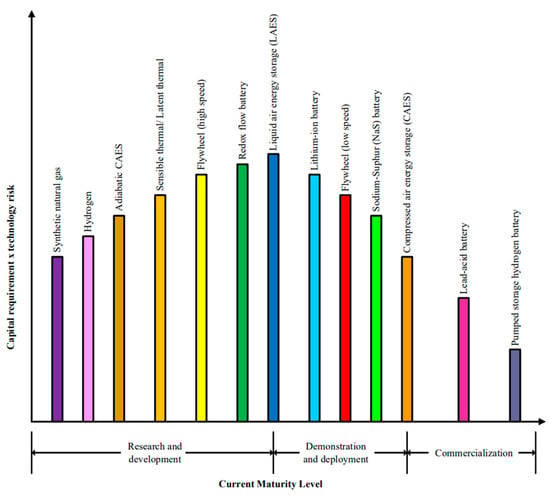
2. Battery Energy Storage Systems
The development of the RES has led to the disruption of conventional power grid operations due to the uncertainties and technical challenges faced by the intermittent nature of RES. This affects transmission grids and creates frequency variations, voltage violations, and network congestion [5]. To address these issues, the ESS, especially battery energy storage systems (BESSs), is a potential solution that can contribute to grid stability. The BESS offers many solutions, including suitable auxiliary services such as backup power supply, supporting peaking capacity, and facilitating energy shifting [6]. BESSs are also important for solving structural problems in the power grid and improving its stability [7,8,9,10]. In the transition to 100% renewable energy networks, a larger renewable energy capacity and ESSs are required to deal with the supply and demand mismatches caused by fluctuations and uncertainty in renewable resources [4].
Battery technologies, such as Lead–Acid, Sodium–Sulphur (NaS), Lithium-Ion (Li-ion), Nickel–Cadmium (NiCd), Zinc–Bromide (ZnBr), and Vanadium redox flow battery (VRFB) can be used as BESSs and integrated with RES to support different power systems. According to Kroposki et al. (2008) [11], batteries store electrical energy in the form of chemical energy during periods of high RES and, subsequently, release it during periods of low energy output to create a balance between supply and demand [12,13]. Furthermore, many batteries used with utility connections have bi-directional converters, which allow energy to be stored and taken from the batteries. The BESS can also provide an alternative solution to ensuring the sustainability of a fixed voltage and frequency operation through ancillary services while using renewable energy sources [14]. Some of the other benefits of BESS include stabilizing fluctuating energy sources and load changes, reliability, enabling load-sharing operations, reducing load spikes and electrical interference, and reducing the cost of ESS.
Other promising ES technologies have emerged over the years as potential solutions, which include compressed air energy storage (CAES), superconducting magnetic energy storage (SMES), electrochemical capacitor energy storage (ECES), and flywheel energy storage (FES) [3]. Figure 1 depicts the different classifications of ESS used in power systems and those that can be integrated with RES [13]. The schematic diagram showing the technological maturity of the ESS, particularly BESS technologies, is shown in Figure 2.

Figure 1. Flowchart showing the ES conversion method.

Figure 2. Technological maturity level of different energy storage systems.

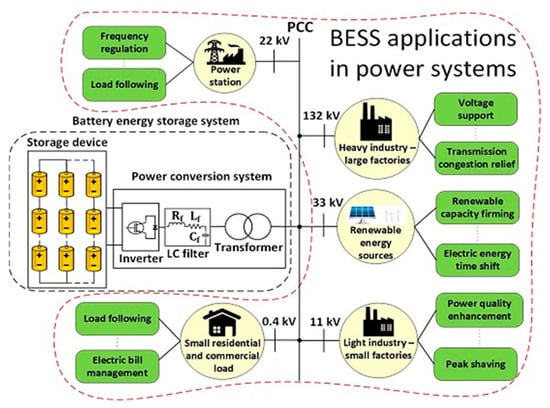
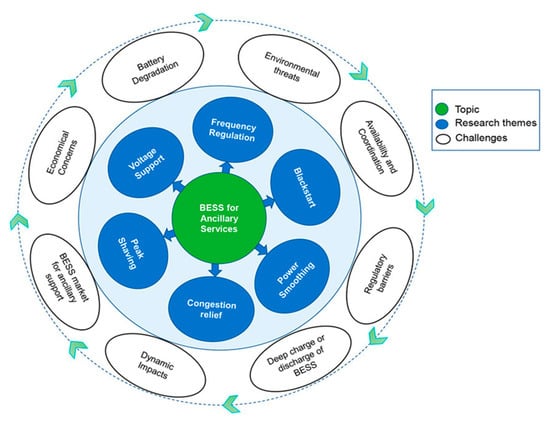
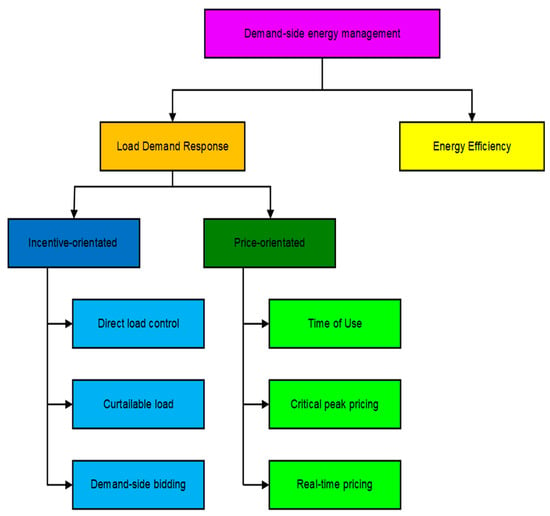
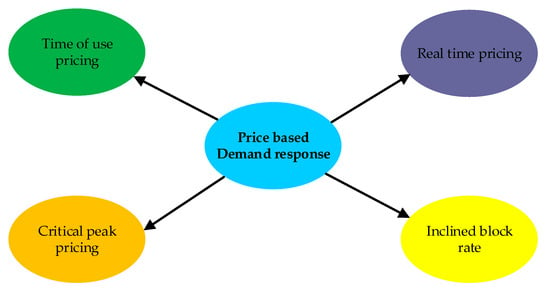
4. BESS Ancillary Services
The BESS is significant in providing ancillary services to the grid. The BESS plays a crucial role in facilitating the integration of RES into the grid by compensating for the fluctuations produced by RESs as intermittent resources [66]. Ancillary services encompass all the services necessary for the grid operator (transmission and distribution operator) to maintain the system’s integrity, stability, and power quality [67]. Grid operators ensure a reliable power supply, frequency, voltage, and power load within certain limits. The schematic diagram of different ancillary services in BESSs is shown in Figure 20 [68].

Figure 20. Ancillary services.
4.1. Evolution and Development of Bess Ancillary Services
Over recent years, research and development have demonstrated the significant evolution of grid ancillary services. These research studies have focused on various crucial services required by the grid, including the integration of RES and BESS, the impact of high-voltage and direct-current (HVDC) grids on ancillary services, the utilization of electric vehicle grid integration systems (EVGI) and the evaluation of grid performance [6,7,69,70,71]. The exploration of distributed energy resource (DES) interconnection codes with PV inverters has also been assessed [72]. Ancillary services work on peak load shifting, frequency regulation, voltage support, smoothing variable generation from renewables, and the optimization of power system operations [73]. Furthermore, potential control strategies have been explored for electric vehicles (EVs) to participate in ancillary services [74]. Multiperiod optimum power flow solutions for active distribution networks have been investigated by [72,75,76]. The feasibility of using a BESS for ancillary services depends on battery investment costs, self-consumption advantages, grid optimization, and applications, as shown in Figure 21 [66,77].

Figure 21. BESS applications in power systems [16].
The potential challenges that can be addressed by BESS ancillary services are shown in Figure 22. These challenges involve battery degradation, economic concerns, environmental threats, regulatory barriers, the charging and discharging of BESS, and dynamic impacts [6].

Figure 22. BESSs for ancillary challenges [6].
The following BESS ancillary services have been identified as a potential solution to provide support and overcome some of the above challenges:
-
Frequency regulation.
-
Congestion relief.
-
Voltage support.
-
Power smoothing (flow control between RES and the grid).
-
Peak shaving (demand-side energy management).
4.1.1. BESSs for Frequency Regulation
The BESS has shown remarkable effectiveness in offering diverse ancillary services to the grid and microgrid. Among these services, it provides frequency regulation in response to changes in grid frequency, quickly adjusting by either injecting or absorbing power. This dynamic response helps maintain a stable frequency within the desired range, preserving grid stability and a reliable power supply [78].
One crucial feature of BESSs for frequency regulation is their optimal placement and storage system sizing. It was observed that the optimal size of BESSs could result in a high-frequency control performance when utilizing the Particle Swarm Optimization (PSO) algorithm compared to other sizing algorithms [79]. The selection of the optimal sizing of BESS depends on parameters such as load-shedding schemes and contingencies [79]. To avoid unnecessary power consumption by BESSs and the smoothing of power grid frequency, diverse control strategies have been developed to enhance frequency regulation. These strategies aim to mitigate the fluctuations in renewable energy generation and monitor the battery state of charge (SOC) [79]. This system’s capacity limit is controlled by a strategy that allows the BESS to switch between frequency regulation and the recharge control strategy [80]. Another approach to the control strategy regulates the frequency between BESS and traditional generators by considering factors such as battery state of charge, the frequency modulation effect, and system economy for optimum results. The BESS centralized control strategy is commonly utilized for frequency regulation [81]. However, a distributed local control-based BESS has high output performances and effectiveness with a faster response between the BESS and other power generation sources.
Frequency control in a microgrid is divided into three levels, namely, primary control, secondary control, and tertiary control. The primary control employs the use of droop control without any communication network [82,83]. This method uses fast stabilizing control actions and can be implemented by voltage and current loops [84]. The secondary control employs microgrid central controllers such as slow control loops and low bandwidth communication systems. These systems are used to measure parameters at certain points of the microgrid and to send back the control output information to each microgrid unit [84]. The tertiary control employs the economic dispatch of DES, which is related to economic optimization [82]. This type of control exchanges relevant information with the Distribution System Operator (DSO) and the optimization of microgrid operation within the utility grid [80].
Ref. [67] is study that covered the voltage and frequency regulation for both distribution and transmission grids. This study addresses load-shedding challenges in South African power networks and offers a list of references related to voltage control techniques. In addition, more studies have efficiently underlined BESS’s frequency regulation. It has been shown in the all-island Irish transmission system that implementing the appropriate BESS capacity could successfully decrease grid frequency fluctuations [85]. Furthermore, economic models and the fuzzy logic theory have also been conducted to optimize the frequency regulation strategy of BESSs. The BESS is vital for maintaining stable power grid frequencies, particularly when RESs are involved. Strategic positioning, sizing, and control methods are used to optimize the BESS’s effectiveness.
4.1.2. BESSs for Congestion Relief
The BESS presents an efficient alternative solution for congestion relief in power grids [6]. It overcomes the limits of traditional methods, such as network configuration and load rescheduling [6]. Moreover, the BESS is utilized as a black start for congestion relief in distribution grids [6]. The following are some of the control strategies and optimization techniques used in BESSs for congestion relief.
Adaptive control algorithms have been developed to control the action of the BESS for voltage regulation and congestion status in distribution grids. Likewise, coordinated control strategies integrating BESSs with other devices, such as on-load tap changers, have been used for voltage regulation and congestion relief [6].
Real-time control frameworks and dispatch algorithms have been proposed to optimize the revenue of BESSs in delivering grid services, including congestion relief [86]. These frameworks underline the potential gains of using the BESS for congestion management in power systems. Disruption can be alleviated by strategically deploying BESSs in the transmission network, which can avoid the need for costly infrastructure upgrades [87].
4.1.3. BESSs for Voltage Support
The BESS has gained recognition for being a solution that contributes to voltage support in power systems, especially when integrating a substantial amount of PV generation into the system [88]. The unstable nature of PV generation often induces voltage fluctuations. Therefore, the BESS can be used to regulate and stabilize the voltage levels of the system [88]. An obstacle when employing the BESS for voltage support is the constant charging/discharging cycles, which directly affect the system’s cost and longevity [6]. The following methods can be used to respond quickly to the fluctuations in PV power and maintain voltage stability. For example, the real-time coordination control strategy has been developed to improve the performance of PV inverters and BESSs for voltage regulation [88]. The moving average algorithm has been commonly used to improve voltage support by smoothing the PV power output. However, the constant charging/discharging implemented by this algorithm can degrade the BESS’s lifespan and create economic drawbacks [6]. Another efficient control strategy has been developed to dynamically adjust the charging and discharging power of the BESS accordingly to prevent premature energy depletion and optimize its overall lifespan [6]. Moreover, the interaction between step voltage regulators (SVRs), PV inverters, and BESSs has been studied for voltage regulation without relying on electronic communication [88]. This interaction is established via a voltage margin control strategy, which guarantees adequate voltage support within the system [88].
4.1.4. BESSs for Power Smoothing
The BESS offers fast response times, modularity, and scalability, making it suitable for applications in power systems [16]. Through fast discharging or charging, the fast-response time deals with the fluctuation in supply or demand. Optimization control and management are essential for addressing RES integration challenges [89]. The integration effect of large-scale BESSs to tackle the problem of the fluctuation and intermittency of renewable power to the grid has been previously investigated. The investigation findings showed that the BESS improved the grid stability and transmission network’s operation [89].
The interaction of the BESS with PV systems performance has also been previously studied. In [90], their study mitigated voltage unbalance and network losses by applying a battery-powered flow control algorithm and injecting real and reactive power into the grid. Furthermore, BESS’s optimal planning and sizing for frequency control in power grids have been widely considered when penetrating renewable RESs and the grid [6]. Integrating the BESS into the microgrid can deliver main and auxiliary services for reliable and efficient power flow control [91]. In another study, ref. [13] investigated various types of BESS and RES usage in power systems. The objective was to generate renewable energy using different scheduling periods. Their results showed that BESS can assist power distribution suppliers by mitigating and smoothing the overall power fluctuations caused by RES intermittent issues.
4.1.5. BESS for Demand-Side Energy Management
The implementation of demand-side energy management (DSEM) programs through customer participation is an important factor that is required to achieve total load optimization as well as a reduction in the microgrid investment cost [92]. The aim of DSEM programs is to change the energy consumption behavior of customers by consuming less power during peak hours and more power in the off-peak hours [93]. The DSEM can be divided into the following two categories: the load demand response (LDR) and energy efficiency (EE). The goal is to reduce customers’ peak energy demand, minimize energy consumption costs, reduce the peak-to-average ratio (PAR), minimize user discomfort by changing the operating behavior of devices, and increase the use of energy generated from local sources. Figure 23 depicts the classification of DSEM [93].

Figure 23. Classification of DSEM.
Load Demand Response
The LDR program provides an avenue to control the load behavior on the network instead of the supplied power. This is conducted through demand shifts and curtailment during the peak periods to reduce cost and maintain a balance between the electric power and the load. The demand response (DR) is grouped into two categories as follows: incentive-oriented or price-oriented programs.
The incentive-oriented program consists of direct load control (DLC), curtailable load (CL), and demand-side bidding (DSB). In the DLC method, the main utilities regulate heavy customers’ loads and appliances during peak demands by turning them off. Some of these heavy loads include air conditioners, microwaves, ovens, refrigerators, and cooling devices. In the CL method, the main utility proposes demand adjustment schedules, while the user controls the usage of appliances. Moreover, rewards are given to users who comply with these schedules while penalty fees are levied on those who disobey them. In the DSB (load shifting) method, users can adjust their loads to improve peak load shaving based on a bidding request in an electricity market [94]. The loads are shifted and distributed evenly without affecting the total consumed energy. Moreover, this program ensures that demand and supply are maintained at the required level while increasing the system’s efficiency.
The price-oriented program consists of the time of use (TOU), critical peak pricing (CPP), real-time pricing (RTP), and inclined block rate (IBR), as shown in Figure 24 [95].

Figure 24. Flowchart diagram of the price-oriented DR.
The TOU program enables the main utility to remotely regulate customers’ appliances by setting different prices for usage times. In this program, the cost of electricity is determined by how much electricity is consumed by the users [94,96]. In the CPP program, a flat pricing strategy or TOU tariff is used annually as an alternative option for small-size peak load usage periods. According to Bakare et al. 2023 [95], energy users who participate in DR programs through the CPP method experience a significant reduction in the cost of energy usage, especially in countries such as North America and Sweden. In the RTP program, spot pricing is implemented on an hourly basis. Hence, energy users are notified hours or days ahead, depending on their electricity market schedules. One limitation of this method is that it is extremely difficult for energy users to actively enroll due to the vigorous back-and-forth communication required by both the utilities (energy providers) and the consumers.
The control strategies often used in DR programs include peak load shaving, valley filling, load leveling, load shifting, and energy arbitrage.
-
Peak load shaving
Peak load shaving or clipping is a traditional DR technique that cuts some portion of users’ loads during peak hours and when consumer demands are very high. BESS is commonly used in peak load shaving to effectively reduce the power grid’s peak demand. Furthermore, during periods of high demand, the BESS can discharge stored energy to meet the increased load, reducing the stress/tension on the grid and possibly avoiding the need for high-cost infrastructure upgrades. The impacts of the peak load shaving and BESS strategies when used with RES in the energy markets have been addressed in the literature. Ref. [97] investigated a residential microgrid, consisting of 144 households, PV, a wind turbine, and BESS. They used a Lead–Acid BESS to overcome the fluctuations caused by the intermittent nature of RES, while the DSM scheme was implemented to shift the peak loads by an hour when the user demand was very low. The results obtained showed that the optimized renewables mix was able to reduce demand fluctuations and improve energy balance. The peak load demand fluctuation per hour in the microgrid was reduced by 19% (12% with renewables mix, 4.6% with a BESS, and 3.5% with DSEM), with one renewable unit and four batteries per household, 83% PV panels and 17% wind turbines.
In another study, Li et al. (2019) [99] concentrated on synchronizing energy-intensive loads (EILs) with a BESS to reduce peak shaving using an optimization framework. This framework includes the neural network algorithm that balances the system operation expenses and wind energy curtailment costs. Papadopoulos et al. (2020) [100] investigated the economic viability of peak shaving with the BESS on real power, charging, and discharging rates. The aim was to analyze the economics of grid-level energy storage for load-shaving applications and the potential of peak shaving through BESSs for low-voltage enterprises with peak demand pricing. The results indicate the economic benefits for certain end-users [100].
-
Valley filling
Valley fillings are periods when low demand is experienced with respect to base loads. In this technique, the use of the BESS and transferable loads can be used to curtail excess energy generation. The impacts of the valley filling and BESS strategies in the energy markets have been addressed in the literature. Augusto et al. (2017a) [105] investigated a valley-filling strategy to restrict transferable loads to off-peak demand scenarios. Their results highlighted the importance of DSEM measures with the reduced levelized cost of electricity to around 18%. Valley fillings have also been investigated by [106], where EVs from a PV/grid system were charged using a rule-based EM system (REMIS).
-
Load leveling
Load leveling is the strategy required for large load fluctuations. In this method, the differences between the peak and low demand profiles are significantly reduced. The impacts of the load leveling, and BESS strategies have been addressed in the literature. Agamah and Ekonomou (2017a) [107] investigated the combination of Lithium-Ion BESSs and the peak demand schedule to improve load leveling and achieve peak demand reduction using genetic algorithm combinatorial optimization (GACO) genetic algorithms. The result obtained showed that the peak load demand was reduced to about 7.69% without combinatorial optimization (GA). When the GA and BESS parameters were introduced, the peak load demand was reduced by 8%.
-
Load shifting
Load shifting is a strategy that involves transferring load demands among different users based on the transferability of such loads and supply availability. The impacts of the load shifting, and BESS strategies have been addressed in the literature. Sepulveda et al. 2018 [109] presented a study that focused on the optimal determination of the best site and size for BESSs in a PV/wind turbine distribution system. The proposed model implemented a genetic algorithm and was tested using the IEEE 123 nodes system (OPENDSS) in MATLAB. The results showed that the grid’s power reverse flow was mitigated, and the cost of energy was reduced, specifically with the BESS.
-
Energy arbitrage
Energy arbitrage is a strategy that can be used to store energy at the time of excess production for use at a time when the power supplies are very low. This strategy is mostly suitable for RES-based systems and can be achieved with a BESS, supercapacitor, air, water, hydrogen, and EV storage [110]. The impacts of energy arbitrage and BESS strategies have been addressed in the literature. Salles et al. (2016) [111] presented a study that used energy arbitrage techniques to improve revenue based on the price volatility in 7395 different electricity markets. In another study, [112] investigated an extended-term BESS arbitrage problem using a bi-level BESS arbitrage solution with high wind power penetration. The bi-level ES arbitrage model consists of an upper level where the ES arbitrage revenue is maximized, with a lower level where the market clearing process is conducted. The simulation result showed that the BESS power and energy ratings should be significantly reduced to achieve a medium-to-high percentage of the optimum revenue.
Energy Efficiency
Energy efficiency is a system of DR that provides energy customers with a favorable service that can require less energy consumption and is economically profitable. Moreover, this method often reduces huge power losses [120]. The characteristics of energy efficiency techniques are presented as follows [121]:
-
Efficient energy devices in households with constant awareness programs towards the better use of energy. An example is using energy-saving bulbs, such as incandescent bulbs and energy-saving air conditioners.
-
Performance check routine with optimal maintenance techniques on electric power equipment should be promoted. An example is recovering heat from waste products.
-
The utilization of distributed generation, optimized control systems for voltage regulation, load flow power factor correction on networks, and data acquisition systems using fiber optics, smart meters, and advanced transformers should be promoted.
On the consumer side, the important criteria to consider when implementing DSEM with a BESS are RES integration, behind-the-meter energy consumption, the load profile of appliances, load categorization, constraints, dynamic pricing, and consumer behaviors. The potential solutions that have been identified to tackle these criteria are peak load shaving, valley filling, load leveling, load shifting, and energy arbitrage. Many control strategies or programs used in the DSEM assist in reducing the wastage of energy, curbing energy consumption when power supplies are very low, and minimizing energy and system costs.
This entry is adapted from the peer-reviewed paper 10.3390/en17040921
This entry is offline, you can click here to edit this entry!
